New to deer stalking, Mo Shiran employs his engineering skills to decide which calibre to go for in his first rifle.
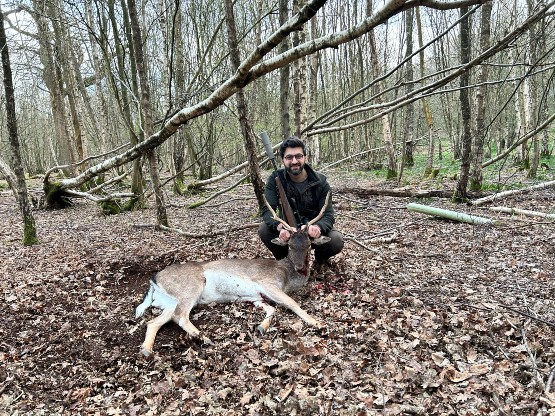
As a novice hunter I was excited to embark on the journey to find the calibre, to purchase my first rifle, and find the best-suited cartridge. The calibre choice was perhaps the first and most important decision - it’s needed for the firearm application and determines the choice of possible rifles and ammunition that can be considered.
So, how does someone new to the world of hunting go about choosing a calibre? With an extensive list of calibres available, it seemed to be a minefield. I shot my first deer with the Capreolus Club’s estate rifle a Sauer 202 Elegance chambered in .243: a beautiful combination. Seasoned hunters Peter Jones and Edward Bebb are big fans of .308 and its versatility; Rory and Ollie fellow club members think the trendy 6.5 Creedmoor does everything .308 does, but better. My father thinks the .270, at almost one hundred years old, is the only calibre I would ever need! Certainly, it was all my grandfather - a very accomplished hunter - needed in his BRNO carbine with iron sight.
So, naturally I reverted to the world of YouTube and spent countless hours watching videos deliberating the pros and cons of different calibres. Instead of finding answers I was introduced to a whole new range of calibres from 260 Remington, 7mm-08 Remington, 6.5x55 Swedish, .30-06, 6.5 PRC, .30-30 Winchester and so many others, all with diehard fans and track records of success. The process was becoming rather overwhelming and so I decided to employ my daily work routine as an engineer to solving the problem, with numbers and graphs. I needed more than just knock-down power, so I also referred to the information provided in the ‘Proficient Deer Stalking Certificate Level 1’ (PDS1) a course that I had completed a few months prior, along with a few guided stalks I had completed with the Capreolus Club, to help define the following key criteria:
- Deliver the UK legal power and velocity at the muzzle. (PDS1 Module 9)
- Flat shooting/ minimum bullet drop with Maximum Point-Blank Range up to 200 yards. (PDS1 Module 4)
- Minimum wind drift. (PDS1 Module 4 & 10)
- Versatility to be used on all deer species in UK. (PDS1 Module 8)
- Availability of Ammo and rifle choices. (PDS1 Module 11)
- Ideally a non-magnum round as I am a novice hunter.
- Woodland deer stalking in England, with occasional trips to the Scottish Highlands. I don’t intend to use this calibre for target shooting, driven hunt, or any large games outside UK.
To reduce the variables, I considered:
- Same bullet type for all calibres
- Cartridges from same manufacturer
- Select bullets of similar weight in each calibre.
Bullet and Cartridges
I found Hornady Ballistic data comprehensive and readily accessible, so I decided to use the Hornady SST bullet 125-140g range in the popular Superformance line of cartridges, with the exception on .243 where the largest bullet offering was 95g and .308 from the Custom Line (not a popular hunting round but fits with the constraints of this mini research. .308 lovers please don’t hate me).
I started the research by shortlisting various calibres recommended by friends and experts in the field they were:
- .243 Winchester
- 7mm-08 Remington
- .308 Winchester
- 6.5x55 Swedish
- 6.5 Creedmoor
- .270 Winchester
Velocity
Generally, faster muzzle velocity means the bullet will be less prone to drop and windage and hit the target harder. Of course, there are other factors in play, such as bullet shape, material, nose tip, twist rate, BC. But it’s a reasonable assumption to use it as an important performance indicator. I was not surprised to see the .270 outperform the other cartridges; that long case can accommodate more powder compared to the other cartridges and push a bullet the same weight significantly faster through the barrel. It is also logical to see two neck-down versions of the .308, 7mm-08 and .243 demonstrate higher velocity than the parent calibre. Narrower bullets with smaller cross section results in lower drag and higher BC.
I did not expect to see the 6.5 CM and 7mm-08 to perform identically (two lines overlay in graph below). How could a calibre introduced in the 1980’s performs as well as a trendy new 6.5CM? It made me consider whether the 6.5CM is a new calibre or a repackaging of the capable 7mm-08?
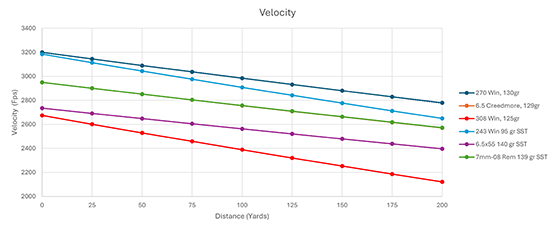
Energy
A cartridge energy is a function of its bullet weight and the speed it travels. Again, the .270 with its laser beam bullet is a clear winner here. Although the 7mm-08, 6.5 CM and 6.5x55 are closely matched, 7mm-08 just take the edge with 8% higher energy at muzzle. .243 loses its advantage in this area because of its lighter bullet and the .308 is also penalised due to its slower bulkier bullet.
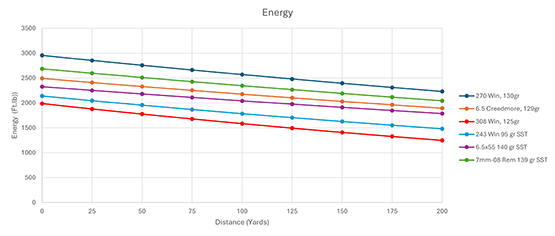
Trajectory
This is the most influential performance matric I would consider in my decision making. A flatter shooting calibre and cartridge can aid a novice as well as a seasoned hunter to reduce the margin of error by providing a longer MPBR without the need for compensating. Another solid performance by .270, closely followed by .243, and yet again identical performance by 7mm-08 and 6.5CM. I was becoming more and more curious why 7mm-08 was not as popular as the 6.5CM.
Looking objectively at this data, most shots taken in woodland are within 50-150 yards and all these calibres perform superbly within this range.
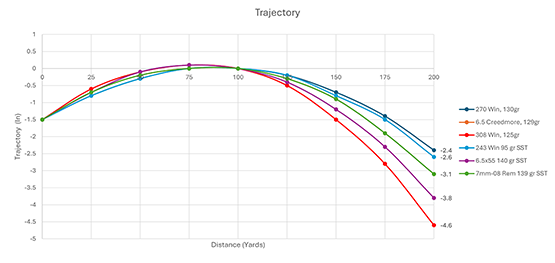
Wind Drift
Although wind drift may not have a tangible impact on the bullet trajectory for close range woodland stalking under coverage of tree and shrubs, I needed to consider occasional trips to the highlands. It was therefore necessary – if the opportunity were to arise to shoot a deer across a glen - to ensure I had the confidence that my bullet will not fly off with the wind. I considered a moderate wind speed of 15mph and for first time the performance of .270 was largely matched by its competition. The .270 is still marginally more resilient to wind at 75-125 yards. The 7mm-08 and 6.5CM performed identically again. The .308 demonstrated the impact of a low BC, bulky bullet under these conditions.
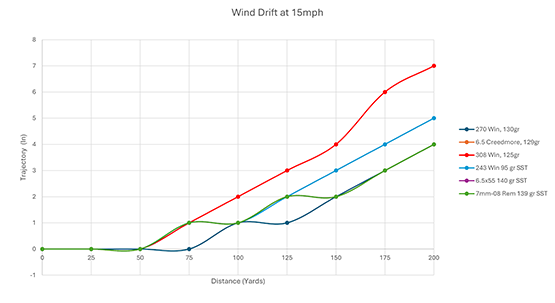
Recoil Energy
OK time to revisit GCSE science! Newton's Third Law of Motion: for every action, there is an equal and opposite reaction. In this case when a gun fires, the bullet goes one way, the gun the other, and generate recoil. For consistency, to calculate the recoil energy for all the above cartridges I considered a Tikka T3x equipped with a Swarovski Z6i rifle scope, without a moderator, at 8 lbs.
So far .270 enjoyed a lot of praise ‘credit due’ to the vast energy behind its bullet. It’s payback time! Energy created by a long action on a light setup can create a kick which may not be comfortable for all shooters. I personally do not think it is excessive and very much manageable in a hunting scenario where you should need just one shot, or perhaps in an unlucky situation, a follow up. For recoil sensitive shooters both the .243 and 6.5 CM could be fantastic options.
I may also have the answer to why the 6.5CM became more popular than 7mm-08: the 6.5CM was originally a competition round where mild recoil can aid better follow through, specially at longer distances, and allows rapid decision making for the next shot. This calibre was later adopted for hunting application. The superb ballistic performance, matched with the low recoil, and an effective marketing campaign by Hornady contributed to this calibre’s enormous success over the past few years.
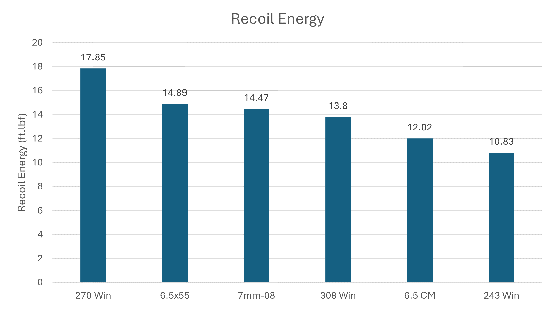
Rifle Availability
Overall, manufacturers offer rifles in most calibres. So, rather than checking every manufacturer website and catalogue, I decided to use the online marketplace ‘Guntrader’ to gauge the availability of different calibre rifles. Perhaps this was not the most scientific approach and provided only a snapshot view, but it gave me a starting point. Should this matric influence the decision-making process? If you are like me, and would like to tamper with everything you buy, or you have a specific build in mind and just need a platform. Or if you are simply looking for a budget gun to start, then this matric could be a consideration.
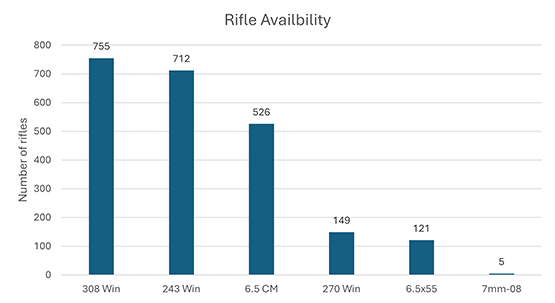
Availability & Cost of Ammunition
Once you have a rifle the next hurdle is access to ammunition. In recent years the firearm industry supply chain has been continuously disrupted due to increased production for military and law enforcement purposes. This also contributes to the scarcity and higher price in the civilian market, not to mention the impact of COVID-19.
To determine the availability and cost of ammunition, I used a similar approach to above, using three reputable UK retailers and taking an average of the number of ammunitions offered per calibre the cost involved.
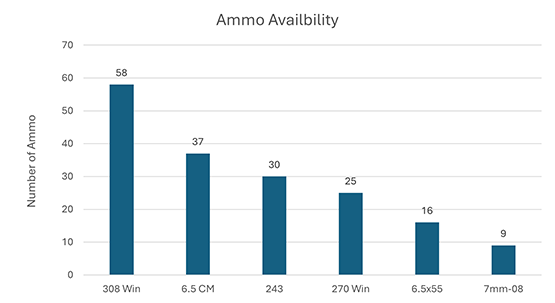
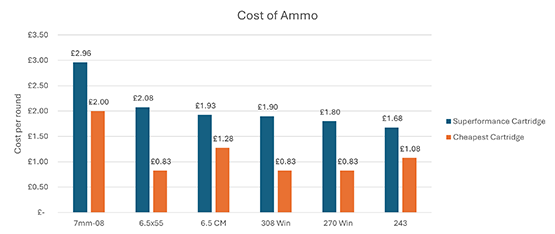
Conclusion
I am certain there are cartridge variants of the calibres considered, with different bullet types, weights, and from other manufactures which outperforms the candidate here. Undoubtedly for the versatile .308 Calibre, the Hornady Custom Line product considered here is very niche and perhaps not the first choice for most hunters, there are similar bullet weight in other cartridges from various manufacturers which outperform the .308, .243 and 6.5 x55 cartridges considered here.
This research, although limited in scope, confirmed that all the calibres considered are infinitely capable for deer hunting in England and Scotland and the choices would be down to personal preference and most importantly choosing the right cartridge for the calibre. My personal short list would be: .270, and 6.5CM, and the calibre I would put in my FAC application would be .270. For me it has the edge on ballistic performance over the 6.5 CM and helps to reduce the margin of error. It is true that it has a bigger kick, but this is manageable for me, and I am also set on the rifle. It also is a special feeling, to know I will be the third generation in the family to hunt with this calibre and to continue a family tradition. So, I guess my father was right – but he also said, “often it is the Indian that makes a bigger difference than the arrow!”
For more on calibres follow this link: rifle-calibres
If you are interested in purchasing a new rifle. You may wish to also take a look at the following link: rifle-reviews
If you are interested in learning to become a ‘Trained Hunter’ then a great place to start is by taking the LANTRA Accredited Proficient Deer Stalking Certificate Level 1 (PDS1). Click here to find out more: deer-stalking-course



















